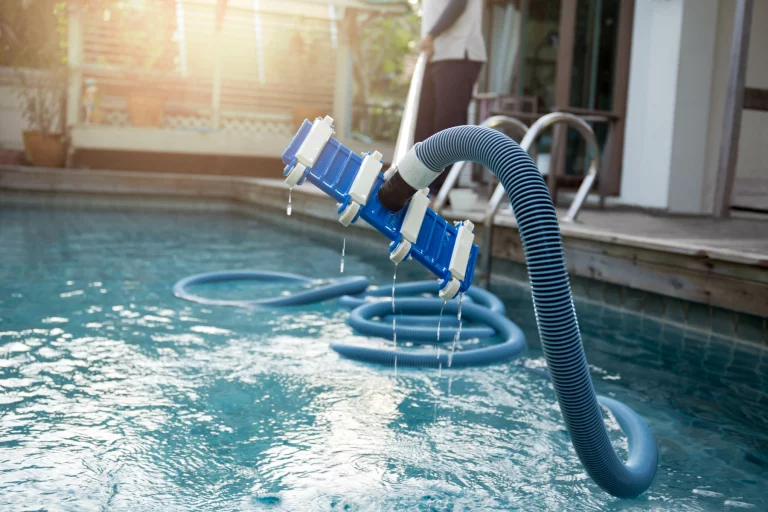Your pool bottom is just like your inside house floor. It gets dirty over time. The way you remove the dirt and debris from your home surface, you should also clean your pool in the same way. Otherwise, your pool will not remain suitable for swimming if you don’t clean it.
But if you are on a budget, we recommend you stick with the manual cleaning and vacuuming method. In Today’s guide, we will show you how to manually clean the in-ground swimming pool. So, stay in tune with us till the end.
We have further covered more handy cleaning tips for keeping your swimming pool crystal cleaner in another chapter.
How To Clean Inground Pool Manually
From this chapter, you can learn what pieces of equipment you need to clean your inground pool manually. Also, you will learn how to use those accessories to pick up dirt from your swimming pool.
Equipment You Need:
- A telescoping pole
- A vacuum head
- A hose
1. Set Those Equipment First
The first thing you need to do is just attach the vacuum head to the vacuum pole. What you should do now is- take the garden hose, and you can find two ends of it. One of the hose ends has a swivel, and the other doesn’t. Getting floodchek hoses are also great to stay away from scams.
Take the swivel-end of the hose and attach it to your vacuum head. Next, grab the telescopic pole and the vac head and drop them into the pool. Now, it’s time to remove the pool skimmer lid in the basket.
2. Flash the Air Out of Your Hose
You should flash out all the air in the hose before plugging the hose into the skimmer. Otherwise, the air into your vacuum hose will be sucked into the system, and you will lose your prime. Consequently, you can’t vacuum your pool properly.
There are a couple of ways you can get the air out of the hose. For instance, you can put the hose into the pole. Then, head over to your pool jet. Hold the hose there, and you can see air bubbles floating up from your pool vacuum head. In this way, you can blow all the air out of your hose.
3. Attach the Hose to The Skimmer Hole
Take the pool vacuum hose and bring it through the skimmer opening and then down it into the hole. Sometimes you can find two holes at the bottom, one might be plugged, and the other may open. Just make sure you plug the hose into the hole that is pulling water.
4. Start Vacuuming Your Pool
Now, you are ready to vacuum your pool. Pass the vacuum head forward and backward the way you vacuum your indoor floor. Keep vacuuming your pool until you cover your entire swimming pool.
Keep in mind; manual pool cleaning is time-taking pool maintenance workflow and requires a lot of elbow grease. Therefore, you can’t pick up every spec of dirt, leaves, and particles by vacuuming your pool manually.
There are several ways to clean your inground pool. You can try the described process if you are short on funds, though, an inground pool cleaner will help speed up the process.
FAQs
How do you get the dirt off the bottom of an inground pool?
Using a robotic vacuum is the best way to catch and trap the dirt, debris, and leaves from your pool bottom. Most robotic pool cleaners deliver enough suction and feature scrubbing brushes to collect every speck of dirt from your pool surface. And the best part is- you don’t need to do anything. The robot will handle everything for you.
Will a pool vacuum pick up dirt?
Yes, a pool vacuum can pick up dirt and debris efficiently. However, you can find some vacuums that can catch large debris, while others can capture tiny particles. Almost every pool vacuum has a scrubbing brush that sucks away dirt & debris into its filter.
How do I get the brown stuff off the bottom of my pool?
Brown stuff means mustard algae, which are chlorine-resistant. So, you need to apply harsh chemicals that are specially designed to kill the algae. Don’t forget to apply a water clarifier as shocking your pool can turn the freshwater cloudy.
What is the white stuff on the bottom of my pool?
White stuff means calcium scale deposits. The calcium deposits may form on your pool bottom if there is a high level of calcium in your pool. Therefore, using a heavy pool shocker chemical can also build calcium deposits on your pool bottom.
Conclusion
The best part of manual pool cleaning is- you don’t need to spend a leg and arm to pick up dirt from your swimming pool. But the downside is- it takes a lot of time and requires a lot of effort to clean your inground pool.
We recommend you get an automatic pool cleaner to suck away dirt with ease. Though you need to spend some bucks, you will enjoy its advantages later. Just pick a robotic, pressure-side, or suction-side pool cleaner that’s suitable for your pool.

